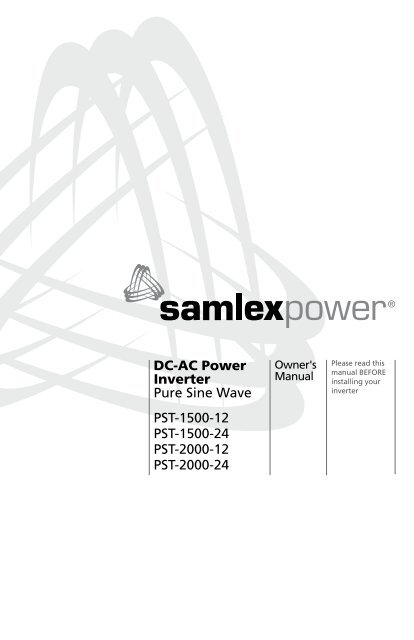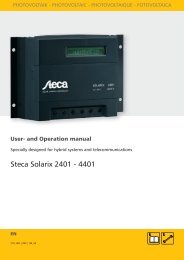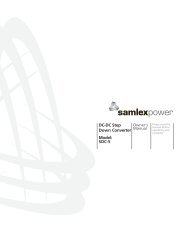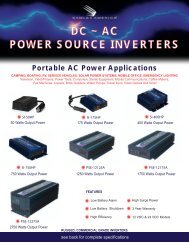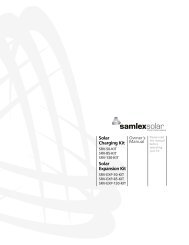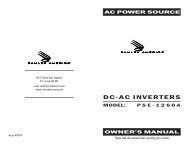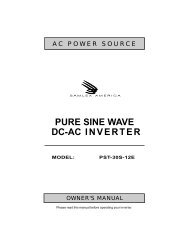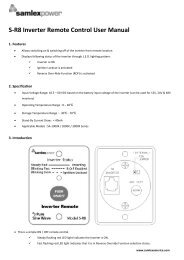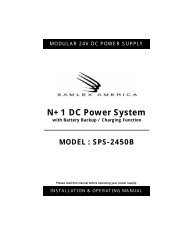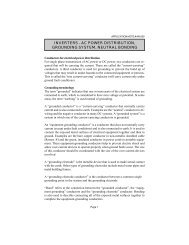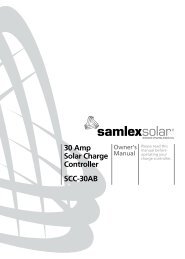DC-AC Power Inverter Pure Sine Wave PST-1500 ... - DonRowe.com
DC-AC Power Inverter Pure Sine Wave PST-1500 ... - DonRowe.com
DC-AC Power Inverter Pure Sine Wave PST-1500 ... - DonRowe.com
You also want an ePaper? Increase the reach of your titles
YUMPU automatically turns print PDFs into web optimized ePapers that Google loves.
Owner's Manual | IndexSection 1 Safety Instructions ........................................3Section 2 General Information......................................6Section 3Limiting Electromagnetic Interference (EMI) ........................ 11Section 4<strong>Power</strong>ing Direct / Embedded Switch Mode<strong>Power</strong> Supplies (SMPS) ........................................................ 12Section 5 Principle of Operation ................................ 14SECTION 6 Layout......................................................... 15Section 7General Information on Batteriesfor <strong>Power</strong>ing <strong>Inverter</strong>s ......................................................... 16Section 8 Installation.................................................. 27Section 9 Operation....................................................36Section 10 Protections .............................................. 38Section 11 Trouble Shooting Guide .......................... 40Section 12 Specifications .......................................... 42Section 13 Warranty...................................................46DETAILED PRODUCT INFORMATIONFor a <strong>com</strong>plete user manual including specifications,application notes, installation instructions, trouble shootingand more, please visit the web page for this product onwww. samlexamerica.<strong>com</strong>. Product page can be found usingthe “Search by Model” field.2 | SAMLEX AMERICA INC.
Section 1 | Safety InstructionsThe following safety symbols will be used in this manual to highlight safetyand information:WARNING!Indicates possibility of physical harm to the user in case of non-<strong>com</strong>pliance.! CAUTION!Indicates possibility of damage to the equipment in case of non-<strong>com</strong>pliance.iINFOIndicates useful supplemental information.Please read these instructions before installing or operating the unit to prevent personalinjury or damage to the unit.SAFETY INSTRUCTIONS - GENERALInstallation and wiring <strong>com</strong>pliance• Installation and wiring must <strong>com</strong>ply with the Local and National Electrical Codes andmust be done by a certified electrician.Preventing electrical shock• Always connect the grounding connection on the unit to the appropriate groundingsystem.• Disassembly / repair should be carried out by qualified personnel only.• Disconnect all <strong>AC</strong> and <strong>DC</strong> side connections before working on any circuits associatedwith the unit. Turning the on/off switch on the unit to off position may not entirelyremove dangerous voltages.• Be careful when touching bare terminals of capacitors. The capacitors may retain highlethal voltages even after the power has been removed. Discharge the capacitorsbefore working on the circuits.Installation environment• The inverter should be installed indoor only in a well ventilated, cool, dryenvironment• Do not expose to moisture, rain, snow or liquids of any type.• To reduce the risk of overheating and fire, do not obstruct the suction and dischargeopenings of the cooling fans.• To ensure proper ventilation, do not install in a low clearance <strong>com</strong>partment.SAMLEX AMERICA INC. | 3
Section 1 | Safety InstructionsPreventing fire and explosion hazards• Working with the unit may produce arcs or sparks. Thus, the unit should not be usedin areas where there are flammable materials or gases requiring ignition protectedequipment. These areas may include spaces containing gasoline-powered machinery,fuel tanks, and battery <strong>com</strong>partments.Precautions when working with batteries• Batteries contain very corrosive diluted sulphuric acid as electrolyte. Precautionsshould be taken to prevent contact with skin, eyes or clothing.• Batteries generate Hydrogen and Oxygen during charging resulting in evolution ofexplosive gas mixture. Care should be taken to ventilate the battery area and followthe battery manufacturer’s re<strong>com</strong>mendations.• Never smoke or allow a spark or flame near the batteries.• Use caution to reduce the risk of dropping a metal tool on the battery. It could sparkor short circuit the battery or other electrical parts and could cause an explosion.• Remove metal items like rings, bracelets and watches when working with batteries.The batteries can produce a short circuit current high enough to weld a ring or thelike to metal and thus cause a severe burn.• If you need to remove a battery, always remove the ground terminal from the batteryfirst. Make sure that all the accessories are off so that you do not cause a spark.SAFETY INSTRUCTIONS - INVERTER RELATEDPreventing Paralleling of the <strong>AC</strong> OutputThe <strong>AC</strong> output of the unit should never be connected directly to an Electrical BreakerPanel / Load Centre which is also fed from the utility power / generator. Such a directconnection may result in parallel operation of the different power sources and <strong>AC</strong>power from the utility / generator will be fed back into the unit which will instantlydamage the output section of the unit and may also pose a fire and safety hazard. If anElectrical Breaker Panel / Load Center is fed from this unit and this panel is also requiredto be fed from additional alternate <strong>AC</strong> sources, the <strong>AC</strong> power from all the <strong>AC</strong> sources(like the utility / generator / this inverter) should first be fed to an Automatic / ManualSelector Switch and the output of the Selector Switch should be connected to the ElectricalBreaker Panel / Load Center.! CAUTION!To prevent possibility of paralleling and severe damage to the unit, never use asimple jumper cable with a male plug on both ends to connect the <strong>AC</strong> outputof the unit to a handy wall receptacle in the home / RV.Preventing <strong>DC</strong> Input Over VoltageIt is to be ensured that the <strong>DC</strong> input voltage of this unit does not exceed 16.5 V<strong>DC</strong> for4 | SAMLEX AMERICA INC.
Section 1 | Safety Instructionsthe 12V battery version and 33.0 V<strong>DC</strong> for the 24V battery version to prevent permanentdamage to the unit. Please observe the following precautions:• Ensure that the maximum charging voltage of the external battery charger / alternator/ solar charge controller does not exceed 16.5 V<strong>DC</strong> for the 12V battery version and33.0 V<strong>DC</strong> for the 24V battery version• Do not use unregulated solar panels to charge the battery connected to this unit.Under cold ambient temperatures, the output of the solar panel may reach > 22 V<strong>DC</strong>for 12V Battery System and > 44 V<strong>DC</strong> for the 24V Battery system. Always use a chargecontroller between the solar panel and the battery.• Do not connect this unit to a battery system with a voltage higher than the rated batteryinput voltage of the unit (e.g. do not connect the 12V version of the unit to 24Vbattery system or the 24V version to the 48V Battery System)Preventing Reverse Polarity on the Input SideWhen making battery connections on the input side, make sure that the polarity of batteryconnections is correct (Connect the Positive of the battery to the Positive terminalof the unit and the Negative of the battery to the Negative terminal of the unit). If theinput is connected in reverse polarity, <strong>DC</strong> fuse(s) inside the inverter will blow and mayalso cause permanent damage to the inverter.! CAUTION!Damage caused by reverse polarity is not covered by warranty.Using Hard Wiring <strong>AC</strong> Output Connections in VehiclesWARNING!RISK OF ELECTRIC SHOCKWhen this unit is installed in vehicles and hard-wiring connection is used tofeed the <strong>AC</strong> output of the inverter to the <strong>AC</strong> Distribution Panel / Load Center inthe vehicle, it is to be ensured that Ground Fault Circuit Interrupter(s) [GFCI]areinstalled in the vehicle wiring system to protect all branch circuits.The following GFCIs have been tested to operate satisfactorily and are acceptable.Other types may fail to operate properly when connected to this inverter:Manufacturerof GFCIManufacturer'sModel No.DescriptionPass & Seymour 2095 Series NEMA5-20 Duplex, 20ALeviton 7899 Series NEMA5-20 Duplex, 20AZhejiang Trimone TGM20 Series NEMA5-20 Duplex, 20ASAMLEX AMERICA INC. | 5
SECTION 2 | General InformationThe following definitions are used in this manual for explaining various electricalconcepts, specifications and operations:Peak Value: It is the maximum value of electrical parameter like voltage / current.RMS (Root Mean Square) Value: It is a statistical average value of a quantity that variesin value with respect to time. For example, a pure sine wave that alternates betweenpeak values of Positive 169.68V and Negative 169.68V has an RMS value of 120 V<strong>AC</strong>.Also, for a pure sine wave, the RMS value = Peak value ÷ 1.414.Voltage (V), Volts: It is denoted by “V” and the unit is “Volts”. It is the electrical forcethat drives electrical current (I) when connected to a load. It can be <strong>DC</strong> (Direct Current– flow in one direction only) or <strong>AC</strong> (Alternating Current – direction of flow changes periodically).The <strong>AC</strong> value shown in the specifications is the RMS (Root Mean Square) value.Current (I), Amps, A: It is denoted by “I” and the unit is Amperes – shown as “A”. It isthe flow of electrons through a conductor when a voltage (V) is applied across it.Frequency (F), Hz: It is a measure of the number of occurrences of a repeating event perunit time. For example, cycles per second (or Hertz) in a sinusoidal voltage.Efficiency, (η): This is the ratio of <strong>Power</strong> Output ÷ <strong>Power</strong> Input.Phase Angle, (φ): It is denoted by “φ” and specifies the angle in degrees by which thecurrent vector leads or lags the voltage vector in a sinusoidal voltage. In a purely inductiveload, the current vector lags the voltage vector by Phase Angle (φ) = 90°. In a purelycapacitive load, the current vector leads the voltage vector by Phase Angle, (φ) = 90°. Ina purely resistive load, the current vector is in phase with the voltage vector and hence,the Phase Angle, (φ) = 0°. In a load consisting of a <strong>com</strong>bination of resistances, inductancesand capacitances, the Phase Angle (φ) of the net current vector will be > 0° < 90°and may lag or lead the voltage vector.Resistance (R), Ω: It is the property of a conductor that opposes the flow of currentwhen a voltage is applied across it. In a resistance, the current is in phase with the voltage.It is denoted by "R" and its unit is "Ohm" - also denoted as "Ω".Inductive Reactance (X L), Capacitive Reactance (X C) and Reactance (X): Reactance is theopposition of a circuit element to a change of electric current or voltage due to thatelement's inductance or capacitance. Inductive Reactance (X L) is the property of a coilof wire in resisting any change of electric current through the coil. It is proportional tofrequency and inductance and causes the current vector to lag the voltage vector byPhase Angle (φ) = 90°. Capacitive reactance (X C) is the property of capacitive elements tooppose changes in voltage. X Cis inversely proportional to the frequency and capacitanceand causes the current vector to lead the voltage vector by Phase Angle (φ) = 90°. Theunit of both X Land X Cis "Ohm" - also denoted as "Ω". The effects of inductive reactanceX Lto cause the current to lag the voltage by 90° and that of the capacitive reactanceX Cto cause the current to lead the voltage by 90° are exactly opposite and the net6 | SAMLEX AMERICA INC.
SECTION 2 | General Informationeffect is a tendency to cancel each other. Hence, in a circuit containing both inductancesand capacitances, the net Reactance (X) will be equal to the difference between thevalues of the inductive and capacitive reactances. The net Reactance (X) will be inductiveif X L> X Cand capacitive if X C> X L.Impedance, Z: It is the vectorial sum of Resistance and Reactance vectors in a circuit.Active <strong>Power</strong> (P), Watts: It is denoted as “P” and the unit is “Watt”. It is the power thatis consumed in the resistive elements of the load. A load will require additional Reactive<strong>Power</strong> for powering the inductive and capacitive elements. The effective power requiredwould be the Apparent <strong>Power</strong> that is a vectorial sum of the Active and Reactive <strong>Power</strong>s.Reactive <strong>Power</strong> (Q), VAR: Is denoted as “Q” and the unit is VAR. Over a cycle, this poweris alternatively stored and returned by the inductive and capacitive elements of the load.It is not consumed by the inductive and capacitive elements in the load but a certainvalue travels from the <strong>AC</strong> source to these elements in the (+) half cycle of the sinusoidalvoltage (Positive value) and the same value is returned back to the <strong>AC</strong> source in the (-)half cycle of the sinusoidal voltage (Negative value). Hence, when averaged over a spanof one cycle, the net value of this power is 0. However, on an instantaneous basis, thispower has to be provided by the <strong>AC</strong> source. Hence, the inverter, <strong>AC</strong> wiring and over currentprotection devices have to be sized based on the <strong>com</strong>bined effect of the Active andReactive <strong>Power</strong>s that is called the Apparent <strong>Power</strong>.Apparent (S) <strong>Power</strong>, VA: This power, denoted by "S", is the vectorial sum of the Active<strong>Power</strong> in Watts and the Reactive <strong>Power</strong> in “VAR”. In magnitude, it is equal to the RMSvalue of voltage “V” X the RMS value of current “A”. The Unit is VA. Please note thatApparent <strong>Power</strong> VA is more than the Active <strong>Power</strong> in Watts. Hence, the inverter, <strong>AC</strong> wiringand over current protection devices have to be sized based on the Apparent <strong>Power</strong>.<strong>Power</strong> Factor, (PF): It is denoted by “PF” and is equal to the ratio of the Active <strong>Power</strong>(P) in Watts to the Apparent <strong>Power</strong> (S) in VA. The maximum value is 1 for resistive typesof loads where the Active <strong>Power</strong> (P) in Watts = the Apparent <strong>Power</strong> (S) in VA. It is 0 forpurely inductive or purely capacitive loads. Practically, the loads will be a <strong>com</strong>bination ofresistive, inductive and capacitive elements and hence, its value will be > 0
SECTION 2 | General Informationthe inverter. The inverter can be sized based on the Active <strong>Power</strong> rating (Watts) withoutcreating overload.Reactive Load: A device or appliance that consists of a <strong>com</strong>bination of resistive, inductiveand capacitive elements (like motor driven tools, refrigeration <strong>com</strong>pressors, microwaves,<strong>com</strong>puters, audio/ video etc.). These devices require Apparent <strong>Power</strong> (VA) fromthe inverter to operate. The Apparent <strong>Power</strong> is a vectorial sum of Active <strong>Power</strong> (Watts)and Reactive <strong>Power</strong> (VAR). The inverter has to be sized based on the higher Apparent<strong>Power</strong> (VA).Output Voltage <strong>Wave</strong>forms18016014012010080604020020406080100120140160180TIME<strong>Pure</strong> <strong>Sine</strong> <strong>Wave</strong>crosses 0.0VinstantaneouslyModified <strong>Sine</strong><strong>Wave</strong> sits atZERO for sometime and thenrises or falls<strong>Sine</strong> <strong>Wave</strong>Modified <strong>Sine</strong> <strong>Wave</strong>Fig. 2.1: <strong>Pure</strong> and Modified <strong>Sine</strong> <strong>Wave</strong>formsThe output waveform of the Samlex <strong>PST</strong> series inverters is a pure sine wave like thewaveform of the grid power. Please see sine wave represented in the Fig. 2.1 that alsoshows modified waveform for <strong>com</strong>parison.In a sine wave, the voltage rises and falls smoothly with a smoothly changing phaseangle and also changes its polarity instantly when it crosses 0 Volts. In a modified sinewave, the voltage rises and falls abruptly, the phase angle also changes abruptly andit sits at 0Vs for some time before changing its polarity. Thus, any device that uses acontrol circuitry that senses the phase (for voltage / speed control) or instantaneous zerovoltage crossing (for timing control) will not work properly from a voltage that has amodified sine waveform.Also, as the modified sine wave is a form of square wave, it is <strong>com</strong>prised of multiplesine waves of odd harmonics (multiples) of the fundamental frequency of the modifiedsine wave. For example, a 60 Hz modified sine wave will consist of sine waves with oddharmonic frequencies of 3rd (180 Hz), 5th (300 Hz), 7th (420 Hz) and so on. The high8 | SAMLEX AMERICA INC.
SECTION 2 | General Informationfrequency harmonic content in a modified sine wave produces enhanced radio interference,higher heating effect in inductive loads like microwaves and motor driven deviceslike hand tools, refrigeration / air-conditioning <strong>com</strong>pressors, pumps etc. The higherfrequency harmonics also produce overloading effect in low frequency capacitors due tolowering of their capacitive reactance by the higher harmonic frequencies. These capacitorsare used in ballasts for fluorescent lighting for <strong>Power</strong> Factor improvement and insingle-phase induction motors as start and run capacitors. Thus, modified and squarewave inverters may shut down due to overload when powering these devices.Advantages of <strong>Pure</strong> <strong>Sine</strong> <strong>Wave</strong> <strong>Inverter</strong>s• The output waveform is a sine wave with very low harmonic distortion and cleanerpower like utility supplied electricity.• Inductive loads like microwaves, motors, transformers etc. run faster, quieterand cooler.• More suitable for powering fluorescent lighting fixtures containing power factorimprovement capacitors and single phase motors containing start and run capacitors• Reduces audible and electrical noise in fans, fluorescent lights, audio amplifiers, TV,fax and answering machines.• Does not contribute to the possibility of crashes in <strong>com</strong>puters, weird print outs andglitches in monitors.Some examples of devices that may not work properly with modified sinewave and may also get damaged are given below:• Laser printers, photocopiers, and magneto-optical hard drives.• Built-in clocks in devices such as clock radios, alarm clocks, coffee makers, bread-makers,VCR, microwave ovens etc. may not keep time correctly.• Output voltage control devices like dimmers, ceiling fan / motor speed control maynot work properly (dimming / speed control may not function).• Sewing machines with speed / microprocessor control.• Transformer-less capacitive input powered devices like (i) Razors, flashlights, nightlights,smoke detectors etc. (ii) Re-chargers for battery packs used in hand powertools. These may get damaged. Please check with the manufacturer of these types ofdevices for suitability.• Devices that use radio frequency signals carried by the <strong>AC</strong> distribution wiring.• Some new furnaces with microprocessor control / Oil burner primary controls.• High intensity discharge (HID) lamps like Metal Halide lamps. These may get damaged.Please check with the manufacturer of these types of devices for suitability.• Some fluorescent lamps / light fixtures that have power factor correction capacitors.The inverter may shut down indicating overload.SAMLEX AMERICA INC. | 9
SECTION 2 | General Information<strong>Power</strong> Rating of the <strong>Inverter</strong>sThe continuous output power rating of the inverter is specified in Active <strong>Power</strong> in Wattsfor resistive types of loads like heating elements, incandescent lamps etc. where <strong>Power</strong>Factor (PF) = 1. The Surge <strong>Power</strong> rating is for < 1 sec.Non resistive / reactive loads with <strong>Power</strong> Factor < 1 like motors (PF = 0.4 to 0.8), non<strong>Power</strong> Factor corrected electronics (PF = 0.5 to 0.6) etc, will draw higher Apparent <strong>Power</strong>in Volt Amps (VA). This Apparent <strong>Power</strong> is the sum of Active <strong>Power</strong> in Watts plus Reactive<strong>Power</strong> in VAR and is = Active <strong>Power</strong> in Watts ÷ <strong>Power</strong> Factor. Thus, for such reactiveloads, higher sized inverter is required based on the Apparent <strong>Power</strong>. Further, all reactivetypes of loads require higher inrush / starting surge power that may last for> 1 to 5 sec and subsequent lower running power. If the inverter is not sized adequatelybased on the type of <strong>AC</strong> load, it is likely to shut down or fail prematurely due torepeated overloading.i INFOThe manufacturers’ specification for power rating of the appliances and devicesindicates only the running power required. The surge power required by somespecific types of devices as explained above has to be determined by actual testingor by checking with the manufacturer. This may not be possible in all casesand hence, can be guessed at best, based on some general rules of thumb.Table 2.1 below lists some <strong>com</strong>mon loads that require high surge power on start up. A“Sizing Factor” has been re<strong>com</strong>mended against each which is a multiplication factorto be applied to the rated running Watt rating of the load to arrive at the Continuous<strong>Power</strong> Rating of the inverter (Multiply the running Watts of the device/ appliance by theSizing Factor to arrive at the size of the inverter).TABLE 2.1: INVERTER SIZING F<strong>AC</strong>TORType of Device or Appliance<strong>Inverter</strong>Sizing Factor*Air Conditioner / Refrigerator / Freezer (Compressor based) 5Air Compressor 4Sump Pump / Well Pump / Submersible Pump 3Dishwasher / Clothes Washer 3Microwave (where rated output power is the cooking power) 2Furnace Fan 3Industrial Motor 3Portable Kerosene / Diesel Fuel Heater 3Circular Saw / Bench Grinder 3Incandescent / Halogen / Quartz Lamps 3Table Continues Next Page ►10 | SAMLEX AMERICA INC.
SECTION 2 | General InformationTABLE 2.1: INVERTER SIZING F<strong>AC</strong>TORType of Device or Appliance<strong>Inverter</strong>Sizing Factor*Laser Printer / Other Devices using Quartz Lamps for heating 4Switch Mode <strong>Power</strong> Supplies (SMPS): no <strong>Power</strong> Factor correction 3Photographic Strobe / Flash Lights 4 (Note 1)* Multiply the Running Active <strong>Power</strong> Rating {Watts} of the appliance by this Factor to arrive atthe Continuous <strong>Power</strong> Rating of the inverter for powering this appliance.TABLE 2.1: NOTES1. For photographic strobe / flash unit, the surge power of the inverter should be> 4 times the Watt Sec rating of photographic strobe / flash unit.SECTION 3 | Limiting Electro-MagneticInterference (EMI)These inverters contain internal switching devices that generate conducted and radiatedelectromagnetic interference (EMI). The EMI is unintentional and cannot be entirelyeliminated. The magnitude of EMI is, however, limited by circuit design to acceptablelevels as per limits laid down in North American FCC Standard FCC Part 15(B), Class B.These limits are designed to provide reasonable protection against harmful interferencewhen the equipment is operated in a residential environment. These inverters canconduct and radiate radio frequency energy and, if not installed and used in accordancewith the instruction manual, may cause harmful interference to radio <strong>com</strong>munications.The effects of EMI will also depend upon a number of factors external to the inverterlike proximity of the inverter to the EMI receptors, types and quality of connecting wiresand cables etc. EMI due to factors external to the inverter may be reduced as follows:i INFO- Ensure that the inverter is firmly grounded to the ground systemof the building or the vehicle- Locate the inverter as far away from the EMI receptors like radio,audio and video devices as possible- Keep the <strong>DC</strong> side wires between the battery and the inverteras short as possible.- Do NOT keep the battery wires far apart. Keep them taped together toreduce their inductance and induced voltages. This reduces ripple in the batterywires and improves performance and efficiency.- Shield the <strong>DC</strong> side wires with metal sheathing / copper foil / braiding:- Use coaxial shielded cable for all antenna inputs (instead of 300 ohm twin leads)- Use high quality shielded cables to attach audio and video devices to one another- Limit operation of other high power loads when operating audio / videoequipmentSAMLEX AMERICA INC. | 11
SECTION 4 | <strong>Power</strong>ing Direct / Embedded SwitchMode <strong>Power</strong> Supplies (SMPS)Switch Mode <strong>Power</strong> Supplies (SMPS) are extensively used to convert the in<strong>com</strong>ing <strong>AC</strong>power into various voltages like 3.3V, 5V, 12V, 24V etc. that are used to power variousdevices and circuits used in electronic equipment like battery chargers, <strong>com</strong>puters, audioand video devices, radios etc. These power supplies use large capacitors in their inputsection for filtration. When the power supply is first turned on, there is a very largeinrush current drawn by the power supply as the input capacitors are charged (The capacitorsact almost like a short circuit at the instant the power is turned on). The inrushcurrent at turn-on is several to tens of times larger than the rated RMS input currentand lasts for a few milliseconds. An example of the input voltage versus input currentwaveforms is given in Fig. 4.1. It will be seen that the initial input current pulse just afterturn-on is > 15 times larger than the steady state RMS current. The inrush dissipates inaround 2 or 3 cycles i.e. in around 33 to 50 milliseconds for 60 Hz sine wave.Further, due to the presence of high value of input filter capacitors, the current drawnby an SMPS (With no <strong>Power</strong> Factor correction) is not sinusoidal but non-linear as shownin Fig 4.2 above. The steady state input current of SMPS is a train of non-linear pulsesinstead of a sinusoidal wave. These pulses are two to four milliseconds duration eachwhen on 50 Hz power, with a very high Crest Factor corresponding to peak valuesaround 3 times the RMS value of the input current:(Crest Factor = Peak value ÷ RMS value).Many SMPS units incorporate “Inrush Current Limiting”. The most <strong>com</strong>mon method isthe NTC (Negative Temperature Coefficient) resistor. The NTC resistor has a high resistancewhen cold and a low resistance when hot. The NTC resistor is placed in series withthe input to the power supply. The cold resistance limits the input current as the inputcapacitors charge up. The input current heats up the NTC and the resistance dropsduring normal operation. However, if the power supply is quickly turned off and backon, the NTC resistor will be hot so its low resistance state will not prevent an inrushcurrent event.The inverter should, therefore, be sized adequately to withstand the high inrush currentand the high Crest Factor of the current drawn by the SMPS. Hence, it is re<strong>com</strong>mendedthat for purposes of sizing the inverter, the continuous power of the inverter should be> 3 times the continuous rated power of the SMPS. For example, an SMPS rated at100 Watts should be powered from an inverter that has continuous power of> 300 Watts.12 | SAMLEX AMERICA INC.
SECTION 4 | <strong>Power</strong>ing Direct / Embedded SwitchMode <strong>Power</strong> Supplies (SMPS)Input voltageInrush currentRMS CurrentFig 4.1: Inrush current in an SMPSNon-linearInput CurrentPeak CurrentRMS CurrentInput <strong>Sine</strong><strong>Wave</strong> VoltageTIMEFig. 4.2: High Crest Factor of current drawn by SMPSSAMLEX AMERICA INC. | 13
SECTION 5 | Principle of OperationThese inverters convert <strong>DC</strong> battery voltage to <strong>AC</strong> voltage with an RMS (Root MeanSquare) value of 120 V<strong>AC</strong>, 60 Hz RMS.The waveform of the <strong>AC</strong> voltage is a pure sine wave form that is same as the waveformof grid power (Supplementary information on pure sine waveform and its advantagesare discussed on pages 8 & 9).Fig. 5.1 below specifies the characteristics of 120 V<strong>AC</strong>, 60 Hz pure sine waveform. Theinstantaneous value and polarity of the voltage varies cyclically with respect to time. Forexample, in one cycle in a 120 V<strong>AC</strong>, 60 Hz system, it slowly rises in the positive directionfrom 0V to a peak positive value “Vpeak” = + 168.69V, slowly drops to 0V, changes thepolarity to negative direction and slowly increases in the negative direction to a peaknegative value “Vpeak” = - 168.69V and then slowly drops back to 0V. There are 60 suchcycles in 1 sec. Cycles per second is called the “Frequency” and is also termed “Hertz(Hz)”.++VPEAK = + 168.69VVRMS = 120 V<strong>AC</strong>OV-TIME-VPEAK = - 168.69VFig. 5.1: 120 V<strong>AC</strong>, 60 Hz <strong>Pure</strong> <strong>Sine</strong> <strong>Wave</strong>formThe voltage conversion takes place in two stages. In the first stage, the <strong>DC</strong> voltageof the battery is converted to a high voltage <strong>DC</strong> using high frequency switching andPulse Width Modulation (PWM) technique. In the second stage, the high voltage <strong>DC</strong> isconverted to 120 V<strong>AC</strong>, 60 Hz sine wave <strong>AC</strong> again using PWM technique. This is done byusing a special wave shaping technique where the high voltage <strong>DC</strong> is switched at a highfrequency and the pulse width of this switching is modulated with respect to a referencesine wave.14 | SAMLEX AMERICA INC.
SECTION 6 | Layout12<strong>PST</strong>-<strong>1500</strong> & <strong>PST</strong>-2000: FRONT1314LN1516<strong>PST</strong>-<strong>1500</strong> & <strong>PST</strong>-2000: FRONT - showing <strong>com</strong>partment containing <strong>AC</strong> output terminals for hardwiring.<strong>PST</strong>-<strong>1500</strong> & <strong>PST</strong>-2000: B<strong>AC</strong>KLEGEND1. <strong>Power</strong> ON/OFF Switch2. Green LED - <strong>Power</strong> ON3. Red LED - Overload4. Red LED - Over Temperature5. NEMA5-20R GFCI Duplex Outlets6. Cooling Fan Opening7. Grounding Lug8. Negative (-) <strong>DC</strong> Input Terminal9. Positive (+) <strong>DC</strong> Input Terminal10. Modular Jack for RC-15ARemote Control11. Metal Strain Relief Clamp for<strong>AC</strong> Output Cable12. Cover Plate for Compartment Containing<strong>AC</strong> Output Terminals13. Compartment Containing <strong>AC</strong> OutputTerminals for Hardwiring14. Terminal for <strong>AC</strong> Output Ground(Chassis Ground)15. <strong>AC</strong> Output: Line Terminal16. <strong>AC</strong> Output: Neutral TerminalFig. 6.1: Layout of <strong>PST</strong>-<strong>1500</strong> and <strong>PST</strong>-2000SAMLEX AMERICA INC. | 15
SECTION 7 | General Information on Batteries for<strong>Power</strong>ing <strong>Inverter</strong>sLead-acid batteries can be categorized by the type of application:1. Automotive service - Starting/Lighting/Ignition (SLI, a.k.a. cranking), and2. Deep cycle service.Deep Cycle Lead Acid Batteries of appropriate capacity are re<strong>com</strong>mended for thepowering of inverters.Deep Cycle Lead Acid BatteriesDeep cycle batteries are designed with thick-plate electrodes to serve as primary powersources, to have a constant discharge rate, to have the capability to be deeply dischargedup to 80 % capacity and to repeatedly accept recharging. They are marketedfor use in recreation vehicles (RV), boats and electric golf carts – so they may be referredto as RV batteries, marine batteries or golf cart batteries. Use Deep Cycle batteries forpowering these inverters.Rated Capacity in Ampere-hour (Ah)Battery capacity “C” is specified in Ampere-hours (Ah). An Ampere is the unit of measurementfor electrical current and is defined as a Coulomb of charge passing through anelectrical conductor in one second. The Capacity “C” in Ah relates to the ability of thebattery to provide a constant specified value of discharge current (also called “C-Rate”)over a specified time in hours before the battery reaches a specified discharged terminalvoltage (Also called “End Point Voltage”) at a specified temperature of the electrolyte.As a benchmark, the automotive battery industry rates batteries at a “Discharge Rate”C/20 Amperes corresponding to 20 Hour discharge period. The rated capacity “C” inAh in this case will be the number of Amperes of current the battery can deliver for 20Hours at 80ºF (26.7ºC) till the voltage drops to 1.75V / Cell. i.e. 10.5V for 12V battery, 21Vfor 24V battery and 42V for a 48V battery. For example, a 100 Ah battery will deliver 5Afor 20 Hours.Rated Capacity in Reserve Capacity (RC)Battery capacity may also be expressed as Reserve Capacity (RC) in minutes typically forautomotive SLI (Starting, Lighting and Ignition) batteries. It is the time in minutes avehicle can be driven after the charging system fails. This is roughly equivalent to theconditions after the alternator fails while the vehicle is being driven at night with theheadlights on. The battery alone must supply current to the headlights and the <strong>com</strong>puter/ignitionsystem. The assumed battery load is a constant discharge current of 25 A.Reserve capacity is the time in minutes for which the battery can deliver 25 Amperes at80ºF (26.7ºC) till the voltage drops to 1.75V / Cell i.e. 10.5V for 12V battery, 21V for 24Vbattery and 42V for 48V battery.Approximate relationship between the two units is:Capacity “C” in Ah = Reserve Capacity in RC minutes x 0.616 | SAMLEX AMERICA INC.
SECTION 7 | General Information on Batteries for<strong>Power</strong>ing <strong>Inverter</strong>sTypical Battery SizesThe Table 7.1 below shows details of some popular battery sizes:Table 7.1: Popular Battery SizesBCI* Group Battery Voltage, V Battery Capacity, Ah27 / 31 12 1054D 12 1608D 12 225GC2** 6 220* Battery Council International; ** Golf CartSpecifying Charging / Discharging Currents: C-RateElectrical energy is stored in a cell / battery in the form of <strong>DC</strong> power. The value of thestored energy is related to the amount of the active materials pasted on the batteryplates, the surface area of the plates and the amount of electrolyte covering the plates.As explained above, the amount of stored electrical energy is also called the Capacity ofthe battery and is designated by the symbol “C”.The time in Hours over which the battery is discharged to the “End Point Voltage” forpurposes of specifying Ah capacity depends upon the type of application. Let us denotethis discharge time in hours by “T”. Let us denote the discharge current of the batteryas the “C-Rate”. If the battery delivers a very high discharge current, the battery will bedischarged to the “End Point Voltage” in a shorter period of time. On the other hand,if the battery delivers a lower discharge current, the battery will be discharged to the“End Point Voltage” after a longer period of time. Mathematically:EQUATION 1:Discharge current “C-Rate” = Capacity “C” in Ah ÷ Discharge Time “T”SAMLEX AMERICA INC. | 17
SECTION 7 | General Information on Batteries for<strong>Power</strong>ing <strong>Inverter</strong>sTable 7.2 below gives some examples of C-Rate specifications and applications:Table 7.2: Discharge current rates - “C-Rates”Hours of discharge time “T”till the “End Point Voltage”C-Rate Discharge Current in AmpsFraction Decimal SubscriptExample of C-RateDischarge Currentsfor 100 Ah battery0.5 Hrs. 2C 2C 2C 200A1 Hrs. 1C 1C 1C 100A5 Hrs. C/5 0.2C C5 20A8 Hrs.(UPS application) C/8 0.125C C8 12.5A10 Hrs.(Tele<strong>com</strong> application) C/10 0.1C C10 10A20 Hrs.(Automotive application) C/20 0.05C C20 5A100 Hrs. C/100 0.01C C100 1ANOTE: When a battery is discharged over a shorter time, its specified “C-Rate” dischargecurrent will be higher. For example, the “C-Rate” discharge current at 5 Hourdischarge period i.e. 0.2C / C5 / C/5 Amps will be 4 times higher than the “C-Rate”discharge current at 20 Hour discharge period i.e. 0.05C / C20 / C/20 Amps.Charging / Discharging CurvesFig. 7.1 (page 19) shows the charging and discharging characteristics of a typical, 6 cell,12V, Lead Acid battery at electrolyte temperature of 80°F / 26.7°C. The curves show the% State of Charge (X-axis) versus terminal voltage (Y-axis) during charging and dischargingat different C-Rates. For 24V battery, multiply voltage on Y-axis by 2 for 48V battery,multiply voltage on Y-axis by 4 (Please note that X-axis shows % State of Charge. Stateof Discharge will be = 100% - % State of Charge). These curves will be referred to insubsequent explanations.Reduction in Usable Capacity at Higher Discharge Rates –Typical in <strong>Inverter</strong> ApplicationAs stated above, the rated capacity of the battery in Ah is normally applicable at a dischargerate of 20 Hours. As the discharge rate is increased as in cases where the invertersare driving higher capacity loads, the usable capacity reduces due to “Peukert Effect”.This relationship is not linear but is more or less according to the Table 7.3 (page 19).18 | SAMLEX AMERICA INC.
SECTION 7 | General Information on Batteries for<strong>Power</strong>ing <strong>Inverter</strong>s12 Volt Lead-Acid Battery Chart - 80˚F / 26.7˚C16.5C/516.015.515.0CHARGEC/10C/20C/40Battery Voltage in V<strong>DC</strong>14.514.013.513.012.512.0C/100C/20C/10DISCHARGEC/5C/311.511.010.510.09.5Please note that X-axis shows %State of Charge. State of Dischargewill be = 100% - % State of Charge.9.00 10 20 30 40 50 60 70 80 90 100 110 120 130Battery State of Charge in Percent (%)Fig. 7.1: Charging / Discharging Curves for 12V Lead Acid BatteryTable 7.3 Battery Capacity versus Rate of Discharge – C-RateC-Rate Discharge Current Usable Capacity (%)C/20 100%C/10 87%C/8 83%C/6 75%C/5 70%C/3 60%C/2 50%1C 40%SAMLEX AMERICA INC. | 19
SECTION 7 | General Information on Batteries for<strong>Power</strong>ing <strong>Inverter</strong>sTable 7.3 (page 19) will show that a 100 Ah capacity battery will deliver 100% (i.e. full100 Ah) capacity if it is slowly discharged over 20 hours at the rate of 5 Amperes (50Woutput for a 12V inverter and 100W output for a 24V inverter). However, if it is dischargedat a rate of 50 Amperes (500W output for a 12V inverter and 1000W output fora 24V inverter) then theoretically, it should provide 100 AH ÷ 50 = 2 hours. However, theTable above shows that for 2 hours discharge rate, the capacity is reduced to 50% i.e. 50Ah. Therefore, at 50 Ampere discharge rate (500W output for a 12V inverter and 1000Woutput for a 24V inverter) the battery will actually last for 50 Ah ÷ 50 Amperes = 1 Hour.State of Charge (SOC) of a Battery – Based on “Standing Voltage”The “Standing Voltage” of a battery under open circuit conditions (no load connectedto it) can approximately indicate the State of Charge (SOC) of the battery. The “StandingVoltage” is measured after disconnecting any charging device(s) and the battery load(s)and letting the battery “stand” idle for 3 to 8 hours before the voltage measurementis taken. Table 7.4 below shows the State of Charge versus Standing Voltage for a 12Vbattery system at 80°F (26.7ºC). For 24-volt systems, multiply by 2; for 48-volt systems,multiply by 4.Table 7.4: State of Charge versus Standing Voltage – 12V BatteryPercentage ofFull ChargeStanding Voltage of 6 Cell,12V Nominal BatteryStanding Voltageof Individual Cells100% 12.63V 2.105V90% 12.6V 2.10V80% 12.5V 2.08V70% 12.3V 2.05V60% 12.2V 2.03V50% 12.1V 2.02V40% 12.0V 2.00V30% 11.8V 1.97V20% 11.7V 1.95V10% 11.6V 1.93V0% = / < 11.6V = / < 1.93VCheck the individual cell voltages / specific gravity. If the inter cell voltage differenceis more than a 0.2 V, or the specific gravity difference is 0.015 or more, the cells willrequire equalization. Please note that only the non-sealed / vented / flooded / wet cellbatteries are equalized. Do not equalize sealed / VRLA type of AGM or Gel Cell Batteries.State of Discharge of a loaded battery – Low Battery /<strong>DC</strong> Input Voltage Alarm and Shutdown in <strong>Inverter</strong>sMost inverter hardware estimate the State of Discharge of the loaded battery by measuringthe voltage at the inverter’s <strong>DC</strong> input terminals (considering that the <strong>DC</strong> input20 | SAMLEX AMERICA INC.
SECTION 7 | General Information on Batteries for<strong>Power</strong>ing <strong>Inverter</strong>scables are thick enough to allow a negligible voltage drop between the battery andthe inverter) .<strong>Inverter</strong>s are provided with a buzzer alarm to warn that the loaded battery has beendeeply discharged to around 80% of the rated capacity. Normally, the buzzer alarm istriggered when the voltage at the <strong>DC</strong> input terminals of the inverter has dropped toaround 10.5V for a 12V battery or 21V for 24V battery at C-Rate discharge current ofC/5 Amps and electrolyte temp. of 80°F. The inverter is shut down if the terminal voltageat C/5 discharge current falls further to 10V for 12V battery (20V for 24V battery).The State of Discharge of a battery is estimated based on the measured terminal voltageof the battery. The terminal voltage of the battery is dependent upon the following:- Temperature of the battery electrolyte: Temperature of the electrolyte affects theelectrochemical reactions inside the battery and produces a Negative VoltageCoefficient – during charging / discharging, the terminal voltage drops with rise intemperature and rises with drop in temperature- The amount of discharging current or “C-Rate”: A battery has non linear internalresistance and hence, as the discharge current increases, the battery terminal voltagedecreases non-linearlyThe discharge curves in Fig. 7.1 (page 19) show the % State of Charge versus the terminalvoltage of a 12V battery under different charge /discharge currents, i.e. “C-Rates”and fixed temperature of 80°F. (Please note that the X-Axis of the curves shows the % ofState of Charge. The % of State of Discharge will be 100% - % State of Charge).Low <strong>DC</strong> Input Voltage Alarm in <strong>Inverter</strong>sAs stated earlier, the buzzer alarm is triggered when the voltage at the <strong>DC</strong> input terminalsof the inverter has dropped to around 10.5V for a 12V battery (21V for 24V battery)at C-Rate discharge current of C/5 Amps. Please note that the terminal voltage relativeto a particular of State Discharge decreases with the rise in the value of the dischargecurrent. For example, terminal voltages for a State of Discharge of 80% (State of Chargeof 20%) for various discharge currents will be as follows (Refer to Fig. 7.1, page 19):Discharge Current:C-RateTerminal Voltage at 80% Stateof Discharge (20% SOC)Terminal Voltage When CompletelyDischarged (0% SOC)C/3 A 10.45V 09.50VC/5 A 10.90V 10.30VC/10 A 11.95V 11.00VC/20 A 11.85V 11.50VC/100 A 12.15V 11.75VSAMLEX AMERICA INC. | 21
SECTION 7 | General Information on Batteries for<strong>Power</strong>ing <strong>Inverter</strong>sIn the example given above, the 10.5V Low Battery / <strong>DC</strong> Input Alarm would trigger ataround 80% discharged state (20% SOC) when the C-Rate discharge current is C/5 Amps.However, for lower C-Rate discharge current of C/10 Amps and lower, the battery will bealmost <strong>com</strong>pletely discharged when the alarm is sounded. Hence, if the C-Rate dischargecurrent is lower than C/5 Amps, the battery may have <strong>com</strong>pletely discharged bythe time the Low <strong>DC</strong> Input Alarm is sounded.Low <strong>DC</strong> Input Voltage Shut-down in <strong>Inverter</strong>s: As explained above, at around 80% Stateof Discharge of the battery at C-Rate discharge current of around C/5 Amps, the Low<strong>DC</strong> Input Voltage Alarm is sounded at around 10.5V for a 12V battery (at around 21Vfor 24V battery) to warn the user to disconnect the battery to prevent further drainingof the battery. If the load is not disconnected at this stage, the batteries will be drainedfurther to a lower voltage and to a <strong>com</strong>pletely discharged condition that is harmful forthe battery and for the inverter.<strong>Inverter</strong>s are normally provided with a protection to shut down the output of theinverter if the <strong>DC</strong> voltage at the input terminals of the inverter drops below a thresholdof around 10V for a 12V battery (20V for 24V battery). Referring to the Discharge Curvesgiven in Fig 7.1 (page 19), the State of Discharge for various C-Rate discharge currentsfor battery voltage of 10V is as follows: (Please note that the X-Axis of the curvesshows the % of State of Charge. The % of State of Discharge will be 100% - % State ofCharge):- 85% State of Discharge (15% State of Charge) at very high C-rate dischargecurrent of C/3 Amps.- 100% State of Discharge (0 % State of Charge) at high C-Rate dischargecurrent of C/5 Amps.- 100% discharged (0% State of charge) at lower C-rate Discharge currentof C/10 Amps.It is seen that at <strong>DC</strong> input voltage of 10V, the battery is <strong>com</strong>pletely discharged for C-ratedischarge current of C/5 and lower.In view of the above, it may be seen that a fixed Low <strong>DC</strong> Input Voltage Alarm is notuseful. Temperature of the battery further <strong>com</strong>plicates the situation. All the aboveanalysis is based on battery electrolyte temperature of 80°F. The battery capacity varieswith temperature. Battery capacity is also a function of age and charging history. Olderbatteries have lower capacity because of shedding of active materials, sulfation, corrosion,increasing number of charge / discharge cycles etc. Hence, the State of Discharge ofa battery under load cannot be estimated accurately. However, the low <strong>DC</strong> input voltagealarm and shut-down function are designed to protect the inverter from excessive currentdrawn at the lower voltage.Use of External Programmable Low Voltage DisconnectsThe above ambiguity can be removed by using an external, programmable Low VoltageDisconnect where more exact voltage threshold can be set to disconnect the batterybased on the actual application requirements.22 | SAMLEX AMERICA INC.
SECTION 7 | General Information on Batteries for<strong>Power</strong>ing <strong>Inverter</strong>sPlease consider using the following Programmable Low Battery Cut-off / “BatteryGuard” Models manufactured by Samlex America, Inc. www.samlexamerica.<strong>com</strong>- BG-40 (40A) – For up to 400W, 12V inverter or 800W, 24V inverter- BG-60 (60A) - For up to 600W, 12V inverter or 1200W, 24V inverter- BG-200 (200A) - For up to 2000W, 12V inverter or 4000W, 24V inverterDepth of Discharge of Battery and Battery LifeThe more deeply a battery is discharged on each cycle, the shorter the battery life. Usingmore batteries than the minimum required will result in longer life for the battery bank.A typical cycle life chart is given in the Table 7.5 below:Table 7.5: Typical Cycle Life ChartDepth of Discharge% of Ah CapacityCycle Life of Group27 /31Cycle Life of Group8<strong>DC</strong>ycle Life of GroupGC210 1000 <strong>1500</strong> 380050 320 480 110080 200 300 675100 150 225 550NOTE: It is re<strong>com</strong>mended that the depth of discharge should be limited to 50%.Series and Parallel Connection of BatteriesSeries ConnectionCable “A”Battery 4 Battery 3Battery 2Battery 124V <strong>Inverter</strong>or 24V Charger6V6V6V6VCable “B”Fig 7.2: Series ConnectionWhen two or more batteries are connected in series, their voltages add up but theirAh capacity remains the same. Fig. 7.2 above shows 4 pieces of 6V, 200 Ah batteriesconnected in series to form a battery bank of 24V with a capacity of 200 Ah. The Positiveterminal of Battery 4 be<strong>com</strong>es the Positive terminal of the 24V bank. The Negativeterminal of Battery 4 is connected to the Positive terminal of Battery 3. The NegativeSAMLEX AMERICA INC. | 23
SECTION 7 | General Information on Batteries for<strong>Power</strong>ing <strong>Inverter</strong>sterminal of Battery 3 is connected to the Positive terminal of Battery 2. The Negativeterminal of Battery 2 is connected to the Positive terminal of Battery 1. The Negative terminalof Battery 1 be<strong>com</strong>es the Negative terminal of the 24V battery bank.Parallel ConnectionCable “A”Battery 1 Battery 2 Battery 3Battery 412V <strong>Inverter</strong>or 12V Charger12V 12V 12V 12VCable “B”Fig 7.3: Parallel ConnectionWhen two or more batteries are connected in parallel, their voltage remains the samebut their Ah capacities add up. Fig. 7.3 above shows 4 pieces of 12V, 100 Ah batteriesconnected in parallel to form a battery bank of 12V with a capacity of 400 Ah. The fourPositive terminals of Batteries 1 to 4 are paralleled (connected together) and this <strong>com</strong>monPositive connection be<strong>com</strong>es the Positive terminal of the 12V bank. Similarly, thefour Negative terminals of Batteries 1 to 4 are paralleled (connected together) and this<strong>com</strong>mon Negative connection be<strong>com</strong>es the Negative terminal of the 12V battery bank.Series – Parallel Connection12V String 1 12V String 2Cable “A”Battery 1 Battery 2 Battery 3Battery 412V <strong>Inverter</strong>or 12V Charger6V 6V 6V 6VCable “B”Fig. 7.4: Series-Parallel ConnectionFigure 7.4 above shows a series – parallel connection consisting of four 6V, 200 AH batteriesto form a 12V, 400 Ah battery bank. Two 6V, 200 Ah batteries, Batteries 1 and 224 | SAMLEX AMERICA INC.
SECTION 7 | General Information on Batteries for<strong>Power</strong>ing <strong>Inverter</strong>sare connected in series to form a 12V, 200 Ah battery (String 1). Similarly, two 6V, 200 Ahbatteries, Batteries 3 and 4 are connected in series to form a 12V, 200 Ah battery(String 2). These two 12V, 200 Ah Strings 1 and 2 are connected in parallel to form a12V, 400 Ah bank.! CAUTION!When 2 or more batteries / battery strings are connected in parallel and arethen connected to an inverter or charger (See Figs 7.3 and 7.4 given above),attention should be paid to the manner in which the charger / inverter is connectedto the battery bank. Please ensure that if the Positive output cable ofthe battery charger / inverter (Cable “A”) is connected to the Positive batterypost of the first battery (Battery 1 in Fig 7.3) or to the Positive battery post ofthe first battery string (Battery 1 of String 1 in Fig. 7.4), then the Negative outputcable of the battery charger / inverter (Cable “B”) should be connected tothe Negative battery post of the last battery (Battery 4 as in Fig. 7.3) or to theNegative Post of the last battery string (Battery 4 of Battery String 2 as inFig. 7.4). This connection ensures the following:- The resistances of the interconnecting cables will be balanced.- All the individual batteries / battery strings will see the same series resistance.- All the individual batteries will charge / discharge at the same chargingcurrent and thus, will be charged to the same state at the same time.- None of the batteries will see an overcharge condition.Sizing the <strong>Inverter</strong> Battery BankOne of the most frequently asked questions is, "how long will the batteries last?" Thisquestion cannot be answered without knowing the size of the battery system and theload on the inverter. Usually this question is turned around to ask “How long do youwant your load to run?”, and then specific calculation can be done to determine theproper battery bank size.There are a few basic formulae and estimation rules that are used:1. Active <strong>Power</strong> in Watts (W) = Voltage in Volts (V) x Current in Amperes (A)x <strong>Power</strong> Factor2. For an inverter running from a 12V battery system, the <strong>DC</strong> current required fromthe 12V batteries is the <strong>AC</strong> power delivered by the inverter to the load in Watts (W)divided by 10 & for an inverter running from a 24V battery system, the <strong>DC</strong> currentrequired from the 24V batteries is the <strong>AC</strong> power delivered by the inverter to theload in Watts (W) divided by 20.3. Energy required from the battery = <strong>DC</strong> current to be delivered(A) x time in Hours (H).SAMLEX AMERICA INC. | 25
SECTION 7 | General Information on Batteries for<strong>Power</strong>ing <strong>Inverter</strong>sThe first step is to estimate the total <strong>AC</strong> watts (W) of load(s) and for how long theload(s) will operate in hours (H). The <strong>AC</strong> watts are normally indicated in the electricalnameplate for each appliance or equipment. In case <strong>AC</strong> watts (W) are not indicated, Formula1 given above may be used to calculate the <strong>AC</strong> watts. The next step is to estimatethe <strong>DC</strong> current in Amperes (A) from the <strong>AC</strong> watts as per Formula 2 above. An exampleof this calculation for a 12V inverter is given below:Let us say that the total <strong>AC</strong> Watts delivered by the 12V inverter = 1000W.Then, using Formula 2 above, the <strong>DC</strong> current to be delivered by the 12V batteries= 1000W ÷10 = 100 Amperes.Next, the energy required by the load in Ampere Hours (Ah) is determined.For example, if the load is to operate for 3 hours then as per Formula 3 above, theenergy to be delivered by the 12V batteries = 100 Amperes × 3 Hours = 300 AmpereHours (Ah).Now, the capacity of the batteries is determined based on the run time andthe usable capacity.From Table 7.3 “Battery Capacity versus Rate of Discharge”, the usable capacity at3 Hour discharge rate is 60%. Hence, the actual capacity of the 12V batteries todeliver 300 Ah will be equal to: 300 Ah ÷ 0.6 = 500 Ah.And finally, the actual desired rated capacity of the batteries is determined based onthe fact that normally only 80% of the capacity will be available with respect to therated capacity due to non availability of ideal and optimum operating and chargingconditions. So the final requirements will be equal to: 500 Ah ÷ 0.8 = 625 Ah (note thatthe actual energy required by the load was 300 Ah).It will be seen from the above that the final rated capacity of the batteries is almost2 times the energy required by the load in Ah. Thus, as a Rule of Thumb, the Ahcapacity of the batteries should be twice the energy required by the load in Ah.For the above example, the 12V batteries may be selected as follows:- Use 6 Group 27/31, 12V, 105 Ah batteries in parallel to make up 630 Ah, or- Use 3 Group 8D, 12V, 225 Ah batteries in parallel to make up 675 Ah.26 | SAMLEX AMERICA INC.
SECTION 8 | InstallationWARNING!1. Before <strong>com</strong>mencing installation, please read the safety instructions explainedin the Section titled “Safety Instructions” on page 3.2. It is re<strong>com</strong>mended that the installation should be undertaken by a qualified,licensed / certified electrician.3. Various re<strong>com</strong>mendations made in this manual on installation will be supersededby the National / Local Electrical Codes related to the location of theunit and the specific application.Location of InstallationPlease ensure that the following requirements are met:Cool: Heat is the worst enemy of electronic equipment. Hence, please ensure that theunit is installed in a cool area that is also protected against heating effects of directexposure to the sun or to the heat generated by other adjacent heat generating devices.Well ventilated: The unit is cooled by convection and by forced air-cooling by temperaturecontrolled fans. The fans suck cool air from air intake openings on the frontand bottom and expel hot air through the exhaust openings next to the fans. To avoidshut down of the inverter due to over temperature, do not cover or block these intake/ exhaust openings or install the unit in an area with limited airflow. Keep a minimumclearance of 10” around the unit to provide adequate ventilation. If installed in an enclosure,openings must be provided in the enclosure, directly opposite to the air intakeand exhaust openings of the inverter.Dry: There should be no risk of condensation, water or any other liquid that can enteror fall on the unit.Clean: The area should be free of dust and fumes. Ensure that there are no insects orrodents. They may enter the unit and block the ventilation openings or short circuit electricalcircuits inside the unit.Protection against fire hazard: The unit is not ignition protected and should not belocated under any circumstance in an area that contains highly flammable liquids likegasoline or propane as in an engine <strong>com</strong>partment with gasoline-fueled engines. Do notkeep any flammable / <strong>com</strong>bustible material (i.e., paper, cloth, plastic, etc.) near the unitthat may be ignited by heat, sparks or flames.Closeness to the battery bank: Locate the unit as close to the battery bank as possibleto prevent excessive voltage drop in the battery cables and consequent power loss andreduced efficiency. However, the unit should not be installed in the same <strong>com</strong>partmentas the batteries (flooded or wet cell) or mounted where it will be exposed to corrosiveacid fumes and flammable Oxygen and Hydrogen gases produced when the batteriesare charged.SAMLEX AMERICA INC. | 27
SECTION 8 | Installation<strong>DC</strong> Side ConnectionsPreventing <strong>DC</strong> Input Over VoltageIt is to be ensured that the <strong>DC</strong> input voltage of this unit does not exceed 16.5 V<strong>DC</strong> forthe 12 -V battery versions and 33.0 V<strong>DC</strong> for the 24 -V battery versions to prevent permanentdamage to the unit. Please observe the following precautions:- Ensure that the maximum charging voltage of the external battery charger / alternator/ solar charge controller does not exceed 16.5 V<strong>DC</strong> for the 12V battery version and33.0 V<strong>DC</strong> for the 24 -V battery version- Do not use unregulated solar panels to charge the battery connected to this unit.Under open circuit conditions and in cold ambient temperatures, the output of thesolar panel may be > 44 V<strong>DC</strong>. Always use a charge controller between the solar paneland the battery.- When using Diversion Charge Control Mode in a charge controller, the solar / wind /hydro source is directly connected to the battery bank. In this case, the controller willdivert excess current to an external load. As the battery charges, the diversion dutycycle will increase. When the battery is fully charged, all the source energy will flowinto the diversion load if there are no other loads. The charge controller will disconnectthe diversion load if the current rating of the controller is exceeded. Disconnectionof the diversion load may damage the battery as well as the inverter or other <strong>DC</strong>loads connected to the battery due to high voltages generated during conditions ofhigh winds (for wind generators), high water flow rates (for hydro generators). It is,therefore, to be ensured that the diversion load is sized correctly to prevent the aboveover voltage conditions.- Do not connect this unit to a battery system with a voltage higher than the rated batteryinput voltage of the unit (e.g. do not connect the 12V version of the unit to 24Vor 48V Battery System)Preventing Reverse Polarity on the Input Side! CAUTION!Damage caused by reverse polarity is not covered by warranty! When makingbattery connections on the input side, make sure that the polarity of batteryconnections is correct (Connect the Positive of the battery to the Positive terminalof the unit and the Negative of the battery to the Negative terminal of theunit). If the input is connected in reverse polarity, <strong>DC</strong> fuse(s) inside the inverterwill blow and may also cause permanent damage to the inverter.Connection from the Batteries to the <strong>DC</strong> Input Side of the Unit –Wire and External Fuse SizesWARNING!The input section of the inverter has large capacitors connected across theinput terminals. As soon as the <strong>DC</strong> input connection loop (Battery (+) terminal► External fuse ► Positive input terminal of the inverter ► Negative input30 | SAMLEX AMERICA INC.
SECTION 8 | Installation<strong>AC</strong> Ground Terminal (14)• Stud: #6 (UNC, 32 Threads Per Inch)Neutral to Chassis Ground Bonding• Neutral “N” (16) is bonded to the metal chassis of the inverter through a loop of wireconnecting the “N” terminal on the Line side of the GFCI to the chassis of the inverter.WARNING!RISK OF ELECTRIC SHOCK. When this unit is installed in vehicles and hard-wiringconnection is used to feed the <strong>AC</strong> output of the inverter to the <strong>AC</strong> DistributionPanel / Load Center in the vehicle, it is to be ensured that Ground Fault CircuitInterrupter(s) [GFCI] are installed in the vehicle wiring system to protect allBranch Circuits.The following GFCIs have been tested to operate satisfactorily and are acceptable. Othertypes may fail to operate properly when connected to this inverter:Mfr. of GFCI Mfr.’s Model No. DescriptionPass & Seymour 2095 Series NEMA5-20 Duplex 20ALeviton 7899 Series NEMA5-20 Duplex 20AZhejiang Trimone TGM20 Series NEMA5-20 Duplex 20A<strong>AC</strong> Output Cable Sizing & Conductor Termination for Hard-wiringUse 3 conductor cable with at least 90 C insulation rating. Based on the maximum outputcurrent of 12.5 A for <strong>PST</strong>-<strong>1500</strong> and 16.7 A for <strong>PST</strong>-2000, the minimum size of each ofthe 3 conductors of the <strong>AC</strong> output cable should be AWG #12 for both the inverters. Thisis the minimum size re<strong>com</strong>mended in NEC Table 310.17 for up to 20 A over current protection.For firm connection when using set screw type of terminals, use Insulated PinType of Terminals for termination of the Line and Neutral conductors and Non InsulatedRing Type of Terminal for the Grounding conductor. For convenience, the followingterminals have been provided:For Line and Neutral wires: Nylon Insulated, Cord EndTerminals for AWG #12 wireFor Neutral wire: Non Insulated Ring Terminal for #6 stud2 pieces1 pieceUse proper crimping Tool to crimp the terminals to the bare ends of the wire. Make surethat the connections are tight and firm. Please ensure that the <strong>AC</strong> cable is adequatelyclamped by the metal Strain Relief Clamp (11).Please use the following type designation of <strong>AC</strong> cord: "SE, SEOO, ST, STO, SJ, SJEOO, SJT,or SJTO."Grounding to Earth or to other designated groundFor safety, ground the metal chassis of the inverter to the Earth Ground or to the otherdesignated ground (For example, in a mobile RV, the metal frame of the RV is normallySAMLEX AMERICA INC. | 35
SECTION 9 | Operationdesignated as the negative <strong>DC</strong> ground). An equipment grounding Lug (7) has been providedfor grounding the metal chassis of the inverter to the appropriate ground.When using the inverter in a building, connect a 10 mm 2 or AWG #8 insulated strandedcopper wire from the above equipment grounding lug to the Earth Ground connection( a connection that connects to the Ground Rod or to the water pipe or to anotherconnection that is solidly bonded to the Earth Ground ). The connections must be tightagainst bare metal. Use star washers to penetrate paint and corrosion.When using the inverter in a mobile RV, connect a 10 mm 2 or AWG #8 insulatedstranded copper wire from the above equipment grounding lug to the appropriateground bus of the RV (usually the vehicle chassis or a dedicated <strong>DC</strong> ground bus). Theconnections must be tight against bare metal. Use star washers to penetrate paint andcorrosion.Optional Wired Remote ControlAn optional Wired Remote Control Model No. RC-200 (with 16.5 ft. / 5 metre cable), isavailable for switching ON and switching OFF. The remote has LCD display showing <strong>AC</strong>output V, A, Hz, W, VA and <strong>Power</strong> Factor. It also has LED indications similar to the indicationson the front panel (2, 3, 4 in Fig. 61). Read Remote Control Manual for details.<strong>Power</strong>ing On The LoadsAfter the inverter is switched on, it takes a finite time to be<strong>com</strong>e ready to deliver fullpower. Hence, always switch on the load(s) after a few seconds of switching on theinverter. Avoid switching on the inverter with the load already switched on. This mayprematurely trigger the overload protection.When a load is switched on, it may require initial higher power surge to start. Hence, ifmultiple loads are being powered, they should be switched on one by one so that theinverter is not overloaded by the higher starting surge if all the loads are switched on atonce.Switching The <strong>Inverter</strong> On/OffBefore switching on the inverter, check that all the <strong>AC</strong> loads have been switched off. Theon/off switch (1) on the front panel of the inverter is used to switch on and switch offthe inverter. This switch operates a low power control circuitry, which in turn controls allthe high power circuitry. Optional Remote Control Model RC-200 may also be used forON/OFF control.! CAUTION!Please note that the On/Off switch is not switching the high power batteryinput circuit. Parts of the <strong>DC</strong> side circuit will still be alive even when the switchis in the off position. Hence, disconnect the <strong>DC</strong> and <strong>AC</strong> sides before workingon any circuits connected to the inverter.36 | SAMLEX AMERICA INC.
SECTION 9 | OperationWhen the inverter is switched on, the GREEN "<strong>Power</strong> ON" LED (2, Fig. 6.1) will belighted. This LED indicates that the input section of the inverter is operating normally.Under normal operating conditions, <strong>AC</strong> output voltage will now be available at the GFCIDuplex Receptacle (5). The Green indicator light on the GFCI will be lighted.Switch on the <strong>AC</strong> load(s). The GREEN "<strong>Power</strong> ON" LED (2) and the indication light onthe GFCI should remain lighted for normal operation of the load.Temperature Controlled Cooling FansTwo cooling fans are thermostatically controlled. Temperature of a critical hot spot insidethe inverter is monitored to activate the fans and the over temperature shut-down. Whenthe temperature of this hot spot reaches 118.4°F / 48°C, the fans are switched on. Thefans will be automatically switched off once the hot spot cools down to 107.6°F / 42°C.Please note that the fans may not <strong>com</strong>e on at low loads or if the ambient temperature iscooler. This is normal.Indications For Normal OperationWhen the inverter is operating normally and supplying <strong>AC</strong> load(s), the GREEN "<strong>Power</strong>ON" LED (2) and the indication light on the GFCI will be lighted. Please see under "ProtectionAgainst Abnormal Conditions" and "Troubleshooting Guide" for symptoms ofabnormal operation.No Load Draw (Idle Current)When the on/off switch is turned on, all the circuitry inside the inverter be<strong>com</strong>es aliveand the <strong>AC</strong> output is made available. In this condition, even when no load is being supplied(or, if a load is connected but has been switched off), the inverter draws a smallamount of current from the batteries to keep the circuitry alive and ready to deliverthe required power on demand. This is called the "idle current" or the "no load draw".Hence, when the load is not required to be operated, turn off the on/off switch onthe inverter to prevent unnecessary current drain from the battery.iINFOWhen the inverter is turned OFF using the optional Remote Control RC-200,some control circuitry in the inverter is still alive and will draw very low current.Therefore, to prevent any drain from the battery, switch OFF the inverter fromthe ON/OFF switch provided on the front panel of the inverter.SAMLEX AMERICA INC. | 37
SECTION 10 | ProtectionsThe inverter has been provided with protections detailed below:Overload / Short Circuit Shut DownThe inverter can provide higher than normal instantaneous power (< 1 second) limitedto the surge power rating of the inverter. Also, the inverter can provide continuouspower limited to the continuous power rating of the inverter. If there is an overloadbeyond these specified limits, the <strong>AC</strong> output of the unit will be shut down permanently.Red LED marked "overload" will turn ON, the GREEN indication on the GFCI will beOFF and buzzer alarm will sound. The GREEN "<strong>Power</strong> ON" LED (2) will continue to belighted. The unit will be latched in this shutdown condition and will require manualreset. To reset, switch off the power On/Off switch, wait for 3 minutes and then switchon again. Before switching on again, remove the cause of the shutdown.Warning Alarm - Low <strong>DC</strong> Input VoltageThe voltage at the <strong>DC</strong> input terminals will be lower than the voltage at the battery terminalsdue to voltage drop in the battery wires and connectors. The drop in the voltageat the <strong>DC</strong> input terminals of the inverter could be due to lower battery voltage or dueto abnormally high drop in the battery wires if the wires are not thick enough (Pleasesee page 31 “Connection From the Batteries To the <strong>DC</strong> Input Side of The Unit – Wire andExternal Fuse Sizes”). If the voltage at the <strong>DC</strong> input terminals falls below 10.5V for 12Vversions or 21.0V for 24V versions, a buzzer alarm will be sounded. The GREEN "<strong>Power</strong>ON" LED (2) and indication light on the GFCI will continue to be lighted and the <strong>AC</strong>output voltage would continue to be available. This warning buzzer alarm indicates thatthe battery is running low and that the inverter will be shut down after sometime if thevoltage at the inverter terminals further drops to 10 V for 12 V versions or 20V for 24Vversions.Low <strong>DC</strong> Input Voltage Shut DownIf the voltage at the <strong>DC</strong> input terminals falls below 10V for 12V versions or 20V for 24Vversions, the <strong>AC</strong> output is shut down. Buzzer alarm is sounded. The GREEN "<strong>Power</strong> ON"LED (2) will remain lighted. The GREEN indication light on the GFCI will be OFF.The unit will reset automatically when the <strong>DC</strong> input voltage rises > 11.5V for 12V versionsand > 23V for 24V versionsHigh <strong>DC</strong> Input Voltage ShutdownIf the voltage at the <strong>DC</strong> input terminals exceeds 16.5V for 12V versions or 33V for24V versions, the inverter will be shut down temporarily. Buzzer alarm will be sounded.The GREEN "<strong>Power</strong> ON" LED (2) will remain lighted. The GREEN indicator light on theGFCI will be OFF. The unit will be reset automatically when the voltage drops down to< 16.5V for 12V versions and to < 33V for 24V versions.38 | SAMLEX AMERICA INC.
SECTION 10 | ProtectionsOver-Temperature Shut DownIn case of failure of the cooling fans or in the case of inadequate heat removal due tohigher ambient temperatures / insufficient air exchange, the temperature inside theunit will increase. The temperature of a critical hot spot inside the inverter is monitoredand at 203°F / 95°C, the <strong>AC</strong> output of the inverter is shut down temporarily. Buzzeralarm will be sounded. The GREEN "<strong>Power</strong> ON"LED (2) will remain lighted. The GREENindication light on the GFCI will be OFF.The unit will automatically reset after the hot spot has cooled down to 158°F / 70°C.Internal <strong>DC</strong> Side FusesThe following <strong>DC</strong> side fuses have been provided for internal protection of the <strong>DC</strong> inputside. The fuses are 32V, Automotive Type Blade Fuses, Type "ATC" by Cooper Bussmannor equivalent:<strong>PST</strong>-<strong>1500</strong>-12: 5 pieces of 40A in parallel = 200A total<strong>PST</strong>-<strong>1500</strong>-24: 5 pieces of 20A in parallel = 100A total<strong>PST</strong>-2000-12: 6 pieces of 40A in parallel = 240A total<strong>PST</strong>-2000-24: 6 pieces of 20A in parallel = 120A totalReverse Polarity at the <strong>DC</strong> Input TerminalsThe Positive of the battery should be connected to the Positive <strong>DC</strong> input terminal of theinverter and the Negative of the battery should be connected to the Negative <strong>DC</strong> inputterminal of the inverter. A reversal of polarity (the Positive of the battery wrongly connectedto the Negative <strong>DC</strong> input terminal of the inverter and the Negative of the batterywrongly connected to the Positive <strong>DC</strong> input terminal of the inverter) will blow theexternal / internal <strong>DC</strong> side fuses. If the <strong>DC</strong> side fuse is blown, the inverter will be dead.The Status LED (2) and the GREEN indication light on the GFCI will be switched off andthere will be no <strong>AC</strong> output.i INFOReverse polarity connection is likely to damage the <strong>DC</strong> input circuitry. The internal fuse(s)should be replaced with the same size of fuse(s) used in the unit. If the unit does not workafter replacing the fuse(s), it has been permanently damaged and will require repair /replacement (Please read Section 11 - “Troubleshooting Guide” for more details).! CAUTION!Damage caused by reverse polarity is not covered by warranty! When making batteryconnections on the input side, make sure that the polarity of battery connections is correct(Connect the Positive of the battery to the Positive terminal of the unit and the Negativeof the battery to the Negative terminal of the unit). If the input is connected in reverse polarity,<strong>DC</strong> fuse(s) inside the inverter / external fuse will blow and may also cause permanentdamage to the inverter.SAMLEX AMERICA INC. | 39
SECTION 11 | Trouble Shooting GuideISSUE POSSIBLE CAUSE REMEDYWhen switched ON, TheGREEN "<strong>Power</strong> ON"LED (2)does not light. Buzzer is off.There is no <strong>AC</strong> output voltage.GREEN indication lighton the GFCI is OFF.There is no voltage at the<strong>DC</strong> input terminals / 12Vpower outlet in the vehicleCheck the continuity of the batteryinput circuit.Check that the internal/external battery fuse/vehicle fuse for 12V power outlet is intact.Replace if blown. When powered from 12Vpower outlet in the vehicle, ensure that the <strong>AC</strong>load is less than 150W.Check that all connections in the battery inputcircuit are tight.Polarity of the <strong>DC</strong> inputvoltage has been reversedthat has blown the external/ internal <strong>DC</strong> side fuses(Note: Reverse polaritymay cause permanentdamage).Check external and internal fuses. Internalfuses may be soldered and may not be easilyreplaceable. Replace fuses. If unit does notwork, call Technical Support for repair.Low <strong>AC</strong> output voltage(No buzzer alarm).Buzzer alarm is sounded whenload is switched on. Voltageat <strong>DC</strong> input terminals readsbetween 10 to 10.5V for 12Vversions and between 20 to21.0V for 24V versions. TheGREEN "<strong>Power</strong> ON" LED (2)is lighted. Indication light onthe GFCI is GREEN. <strong>AC</strong> outputvoltage is available.Low input voltage at theinverter terminals and theload is close to the maximumallowable power.<strong>DC</strong> input voltage is lessthan 10.5V for 12Vversions and less than21.0V for 24V versions.Check that the battery is fully charged. Recharge,if low.Check that the battery cables are thick enoughto carry the required current over the requiredlength. Use thicker cables, if required.Tighten connections of battery input circuit.Reduce load.Check that the battery is fully charged. Recharge,if low.Check that the battery cables are thick enoughto carry the required current over the requiredlength. Use thicker cables, if required.Tighten connections of the battery input circuit.Buzzer alarm is soundedwhen load is switched on.Voltage at the <strong>DC</strong> inputterminals reads below 10Vfor 12V versions and below20V for 24V versions. TheGREEN "<strong>Power</strong> ON" LED (2)is lighted. GREEN indicationlight on the GFCI is OFF. Thereis no <strong>AC</strong> output.Shut-down due to low<strong>DC</strong> input voltage - Lessthan 10V for 12V versionsand less than 20V for 24Vversions.Check that the battery is fully charged. Recharge,if low.Check that the battery cables are thick enoughto carry the required current over the requiredlength. Use thicker cables, if required.Tighten connections of the battery input circuit.40 | SAMLEX AMERICA INC.
SECTION 11 | Trouble Shooting GuideISSUE POSSIBLE CAUSE REMEDYThere is no <strong>AC</strong> output. TheGREEN "<strong>Power</strong> ON" LED(2) is lighted. Buzzer is on.GREEN indication light on theGFCI is OFF.<strong>AC</strong> output shuts down <strong>com</strong>pletely.Red "Overload" LED(3) is lighted. Buzzer is ON.The GREEN "<strong>Power</strong> ON" LED(2) is lighted. GREEN indicationlight on the GFCI is OFF.There is no <strong>AC</strong> output. Buzzeralarm is sounded. Red "Overtemperature" LED (4) islighted. The GREEN "<strong>Power</strong>ON LED (2) is lighted. GREENindication light on the GFCIis OFF.There is no <strong>AC</strong> output.GREEN indication on the GFCIis OFF. The GREEN "<strong>Power</strong>ON" LED (2) is lighted. Nobuzzer alarm.Shut-down due to highinput <strong>DC</strong> voltage –> 16.5V for 12V versionsand > 33V for 24Vversions.Permanent shut-down ofthe <strong>AC</strong> output due to continuousoverload beyondthe continuous powerrating of the inverter.Shut-down due to overtemperature because offan failure or inadequatecooling as a result of highambient temperature orinsufficient air exchangeGFCI has tripped due toleakaage or due to Neutralto Ground bond on theload side.Check that the voltage at the <strong>DC</strong> input terminalsis less than 16.5V for 12V versions and lessthan 33V for 24V versions.Ensure that the maximum charging voltage ofthe battery charger / alternator / solar chargecontroller is below 16.5V for 12V versions andbelow 33V for 24V versions.Ensure that an unregulated solar panel is notused to charge a battery. Under cold ambienttemperatures, the output of the solar panelmay exceed 22V for 12V system or 42V for24 V system. Ensure that a charge controller isused between the solar panel and the battery.Reduce the load.The load is not suitable as it requires higherpower to operate. Use an inverter with higherpower rating.If the unit goes into permanent overload againafter resetting and removing the load <strong>com</strong>pletely,the unit has be<strong>com</strong>e defective.Call Technical support.Note: The unit will be latched in this shutdowncondition and will require manual reset.To reset, switch off the powerOn/Off switch, wait for 3 minutes and thenswitch on again.Before switching on again, remove the causeof the shut-down.Check that the fans are working. If not, the fancontrol circuit may be defective. CallTechnical Support.If the fans are working, check that the ventilationslots on the suction side and the openingson the discharge side of the fans are notobstructed.If the fans are working and the openingsare not obstructed, check that enough coolreplacement air is available. Also check that theambient air temperature is less than 40ºC.Reduce the load to reduce the heating effect.After the cause of overheating is removed andthe unit cools down sufficiently, it will resetautomatically.Check load side circuits for leakage or Neutralto Ground bonding and correct. Press "ResetButton" on the GFCI to reset. Ensure that theinverter is ON before re-setting.SAMLEX AMERICA INC. | 41
SECTION 12 | SpecificationsModel No. <strong>PST</strong>-<strong>1500</strong>-12 <strong>PST</strong>-<strong>1500</strong>-24OUTPUTOUTPUT VOLTAGE 120 V<strong>AC</strong> ± 3% 120 V<strong>AC</strong> ± 3%MAXIMUM OUTPUT CURRENT 12.5A 12.5AOUTPUT FREQUENCY 60 Hz ± 1% 60 Hz ± 1%TYPE OF OUTPUT WAVEFORM <strong>Pure</strong> <strong>Sine</strong> <strong>Wave</strong> <strong>Pure</strong> <strong>Sine</strong> <strong>Wave</strong>TOTAL HARMONIC DISTORTION OFOUTPUT WAVEFORM< 3% < 3%CONTINUOUS OUTPUT POWER (At <strong>Power</strong> Factor = 1) <strong>1500</strong> Watts <strong>1500</strong> WattsSURGE OUTPUT POWER (At <strong>Power</strong> Factor = 1;
SECTION 12 | SpecificationsModel No. <strong>PST</strong>-2000-12 <strong>PST</strong>-2000-24OUTPUTOUTPUT VOLTAGE 120 V<strong>AC</strong> ± 3% 120 V<strong>AC</strong> ± 3%MAXIMUM OUTPUT CURRENT 16.7A 16.7AOUTPUT FREQUENCY 60 Hz ± 1% 60 Hz ± 1%TYPE OF OUTPUT WAVEFORM <strong>Pure</strong> <strong>Sine</strong> <strong>Wave</strong> <strong>Pure</strong> <strong>Sine</strong> <strong>Wave</strong>TOTAL HARMONIC DISTORTION OFOUTPUT WAVEFORM< 3% < 3%CONTINUOUS OUTPUT POWER (At <strong>Power</strong> Factor = 1) 2000 Watts 2000 WattsSURGE OUTPUT POWER (At <strong>Power</strong> Factor = 1;
SECTION 12 | Specifications!CAUTION! RISK OF FIREDo not replace any vehicle fuse with a rating higher than re<strong>com</strong>mended bythe vehicle manufacturer. This product is rated to draw 240 Amperes from 12V vehicleoutlet and 120 Amperes from 24V battery vehicle outlet. Ensure that the electrical systemin your vehicle can supply this product without causing the vehicle fusing to open.This can be determined by making sure that the fuse in the vehicle, which protects theoutlet, is rated higher 240 amperes (12V battery), or 120 amperes (24V battery). Informationon the vehicle fuse ratings is typically found in the vehicle operator's manual. Ifa vehicle fuse opens repeatedly, do not keep on replacing it. The cause of the overloadmust be found. On no account should fuses be patched up with tin foil or wire as thismay cause serious damage elsewhere in the electrical circuit or cause fire.SAMLEX AMERICA INC. | 45
SECTION 13 | Warranty2 Year limited warrantyThe <strong>PST</strong>-<strong>1500</strong>-12, <strong>PST</strong>-<strong>1500</strong>-24, <strong>PST</strong>-2000-12 and <strong>PST</strong>-2000-24 are manufactured by SamlexAmerica, Inc. (the “Warrantor“) is warranted to be free from defects in workmanshipand materials under normal use and service. The warranty period is 2 years for theUnited States and Canada, and is in effect from the date of purchase by the user (the“Purchaser“).Warranty outside of the United States and Canada is limited to 6 months. For a warrantyclaim, the Purchaser should contact the place of purchase to obtain a Return AuthorizationNumber.The defective part or unit should be returned at the Purchaser’s expense to the authorizedlocation. A written statement describing the nature of the defect, the date of purchase,the place of purchase, and the Purchaser’s name, address and telephone numbershould also be included.If upon the Warrantor’s examination, the defect proves to be the result of defectivematerial or workmanship, the equipment will be repaired or replaced at the Warrantor’soption without charge, and returned to the Purchaser at the Warrantor’s expense.(Contiguous US and Canada only)No refund of the purchase price will be granted to the Purchaser, unless the Warrantoris unable to remedy the defect after having a reasonable number of opportunities to doso. Warranty service shall be performed only by the Warrantor. Any attempt to remedythe defect by anyone other than the Warrantor shall render this warranty void. Thereshall be no warranty for defects or damages caused by faulty installation or hook-up,abuse or misuse of the equipment including exposure to excessive heat, salt or freshwater spray, or water immersion.No other express warranty is hereby given and there are no warranties which extendbeyond those described herein. This warranty is expressly in lieu of any other expressedor implied warranties, including any implied warranty of merchantability, fitness for theordinary purposes for which such goods are used, or fitness for a particular purpose, orany other obligations on the part of the Warrantor or its employees and representatives.There shall be no responsibility or liability whatsoever on the part of the Warrantor orits employees and representatives for injury to any persons, or damage to person orpersons, or damage to property, or loss of in<strong>com</strong>e or profit, or any other consequentialor resulting damage which may be claimed to have been incurred through the use orsale of the equipment, including any possible failure of malfunction of the equipment,or part thereof. The Warrantor assumes no liability for incidental or consequential damagesof any kind.Samlex America Inc. (the “Warrantor”)www.samlexamerica.<strong>com</strong>46 | SAMLEX AMERICA INC.
NOTES:SAMLEX AMERICA INC. | 47
ContactInformationToll Free NumbersPh: 800 561 5885Fax: 888 814 5210Local NumbersPh: 604 525 3836Fax: 604 525 5221Websitewww.samlexamerica.<strong>com</strong>USA Shipping WarehouseKent W<strong>AC</strong>anadian Shipping WarehouseDelta BCEmail purchase orders toorders@samlexamerica.<strong>com</strong>11001-<strong>PST</strong>-<strong>1500</strong>-2000-12-24-1212


